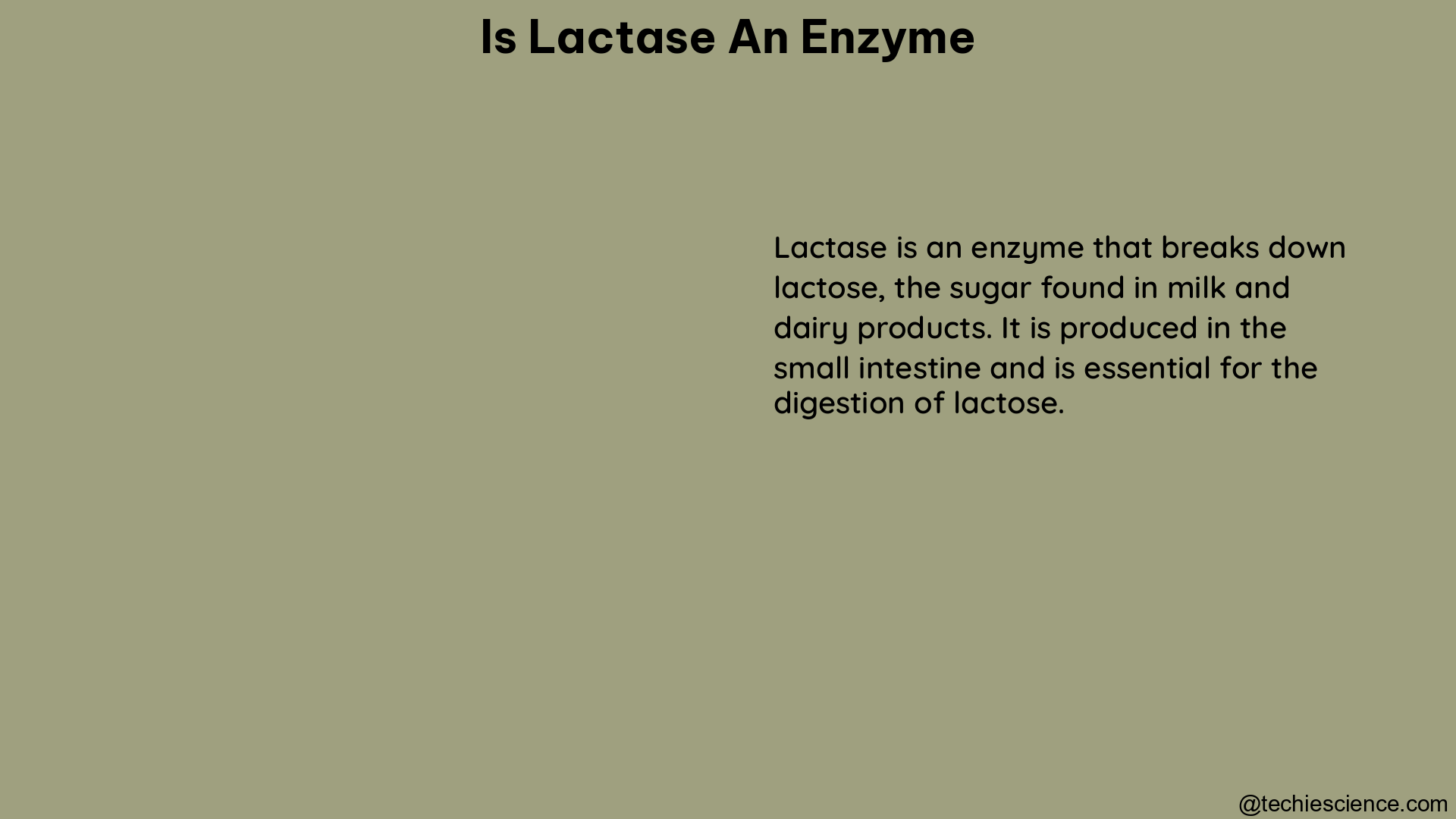Summary
Lactase is a crucial enzyme responsible for the digestion of lactose, a disaccharide found in milk and dairy products. This enzyme is produced in the small intestine of humans and other mammals, allowing them to break down lactose into its constituent monosaccharides, glucose and galactose. However, many adults experience lactose intolerance due to a decline in lactase production, making it difficult for them to properly digest lactose. In a teaching lab setting, the activity of lactase can be measured using various methods, providing valuable insights into the field of enzyme biology and the importance of this enzyme in human health and nutrition.
Understanding Lactase: The Enzyme that Breaks Down Lactose

Lactase is a member of the glycoside hydrolase family of enzymes, specifically classified as a disaccharidase. Its primary function is to catalyze the hydrolysis of lactose, a disaccharide composed of glucose and galactose, into these two monosaccharides. This process is essential for the proper digestion and absorption of lactose in the human body.
The Structure and Function of Lactase
Lactase is a large, globular protein composed of approximately 1,024 amino acids. Its structure consists of two distinct domains: a catalytic domain and a lectin-like domain. The catalytic domain contains the active site where the hydrolysis of lactose takes place, while the lectin-like domain is responsible for binding to the lactose substrate.
The mechanism of action for lactase involves the following steps:
- Lactose binds to the active site of the enzyme, where the glycosidic bond between the glucose and galactose moieties is positioned.
- A water molecule is activated by a catalytic amino acid residue, typically a glutamic acid, which acts as a nucleophile and attacks the anomeric carbon of the glucose moiety.
- This results in the formation of a covalent intermediate, with the glucose moiety remaining bound to the enzyme.
- A second catalytic amino acid, typically an aspartic acid, acts as a general base and facilitates the hydrolysis of the covalent intermediate, releasing the glucose and galactose products.
The hydrolysis of lactose by lactase is a crucial step in the digestion and absorption of dairy products, as it allows the body to utilize the energy and nutrients provided by the glucose and galactose molecules.
Lactase Production and Regulation
Lactase is primarily produced by the cells lining the small intestine, known as enterocytes. The expression of the lactase gene (LCT) is regulated by various transcription factors and epigenetic mechanisms, which can influence the level of lactase production throughout an individual’s lifespan.
In humans, lactase production is typically highest during infancy and early childhood, when the body requires a reliable source of energy and nutrients from milk. However, as individuals age, the expression of the lactase gene often decreases, leading to a decline in lactase production and the development of lactose intolerance in many adults.
The regulation of lactase production is a complex process that involves both genetic and environmental factors. Certain genetic variants in the LCT gene can lead to persistent lactase production (lactase persistence) or early cessation of lactase production (lactase non-persistence), contributing to the varying prevalence of lactose intolerance across different populations and ethnic groups.
Measuring Lactase Activity in the Teaching Lab
In a teaching lab setting, the activity of lactase can be measured using various methods, providing students with hands-on experience in the field of enzymology and enzyme kinetics.
Colorimetric Assay for Lactase Activity
One common method for measuring lactase activity is the colorimetric assay, which utilizes an artificial substrate and a color-based detection system. The protocol typically involves the following steps:
- Prepare a solution containing the artificial substrate, such as o-nitrophenyl-β-D-galactopyranoside (ONPG), which is a colorless compound.
- Add the lactase enzyme to the substrate solution and incubate for a specific duration, allowing the enzyme to catalyze the hydrolysis of the substrate.
- During the hydrolysis, the ONPG is converted into o-nitrophenol, a yellow-colored compound.
- Measure the absorbance of the solution at a specific wavelength (typically around 420 nm) using a spectrophotometer.
- The absorbance reading is directly proportional to the amount of o-nitrophenol produced, which in turn reflects the activity of the lactase enzyme.
By varying the experimental conditions, such as substrate concentration, temperature, or the presence of inhibitors, students can explore the kinetic properties of lactase and gain a deeper understanding of enzyme behavior.
Glucose Detection Strips for Lactase Activity
Another method for measuring lactase activity involves the use of glucose detection strips, which contain the enzyme glucose oxidase and a color-changing dye, such as toluidine blue.
The protocol for this method is as follows:
- Prepare a solution containing the lactose substrate and the sample containing the lactase enzyme.
- Incubate the solution for a specific duration, allowing the lactase to hydrolyze the lactose into glucose and galactose.
- Dip a glucose detection strip into the solution and observe the color change.
- The glucose oxidase enzyme within the strip will convert the glucose into gluconic acid and hydrogen peroxide, which will then interact with the toluidine blue dye, causing a color change from blue to green, yellow, and eventually brown.
- The intensity of the color change can be used to estimate the activity of the lactase enzyme, as it is directly proportional to the amount of glucose produced.
This method provides a simple and visual way for students to assess lactase activity, while also introducing them to the principles of enzymatic reactions and glucose detection.
Extending the Experiments
The basic protocols for measuring lactase activity can be further extended and adapted to suit the specific needs and interests of the student cohort. Some possible extensions include:
- Repeated measurements at different temperatures to investigate the effect of temperature on lactase activity and enzyme kinetics.
- Varying the substrate (lactose) concentration to determine the Michaelis-Menten kinetic parameters, such as the maximum velocity (Vmax) and the Michaelis constant (Km).
- Assessing the impact of heat denaturation on lactase activity by exposing the enzyme to different temperatures and durations.
- Carrying out competition experiments by adding lactose or other potential inhibitors to the reaction mixture to study the effects on lactase activity.
- Exploring the role of cofactors, such as calcium or magnesium ions, in the catalytic activity of lactase.
By engaging in these hands-on experiments, students can develop a deeper understanding of the structure, function, and regulation of lactase, as well as the broader principles of enzyme biology and their relevance in human health and nutrition.
Conclusion
Lactase is a crucial enzyme that plays a vital role in the digestion and absorption of lactose, a disaccharide found in milk and dairy products. Its activity can be measured and quantified in a teaching lab setting using various methods, providing valuable insights into the field of enzyme biology and the importance of this enzyme in human health and nutrition.
Through the exploration of lactase activity, students can gain a deeper understanding of the structure and function of enzymes, the mechanisms of enzymatic reactions, and the factors that influence enzyme kinetics. These hands-on experiments not only enhance the students’ knowledge but also develop their critical thinking and problem-solving skills, preparing them for future endeavors in the field of biology and beyond.
References:
- Got Lactase? Quiz Flashcards | Quizlet. (n.d.). Retrieved from https://quizlet.com/362178906/got-lactase-quiz-flashcards/
- Measuring Lactase Enzymatic Activity in the Teaching Lab – PMC. (2018, August 6). Retrieved from https://www.ncbi.nlm.nih.gov/pmc/articles/PMC6126642/
- Measuring the Enzymatic Activity of Lactase – LOUIS Pressbooks. (n.d.). Retrieved from https://louis.pressbooks.pub/generalbiology1lab/chapter/measuring-the-enzymatic-activity-of-lactase/
- Lactase – an overview | ScienceDirect Topics. (n.d.). Retrieved from https://www.sciencedirect.com/topics/biochemistry-genetics-and-molecular-biology/lactase
- Lactase Persistence and Lactose Intolerance – PMC. (2010, January 1). Retrieved from https://www.ncbi.nlm.nih.gov/pmc/articles/PMC2879868/
- Lactase – Structure, Function and Regulation – NCBI Bookshelf. (n.d.). Retrieved from https://www.ncbi.nlm.nih.gov/books/NBK279225/

Hello, I am Sugaprabha Prasath, a Postgraduate in the field of Microbiology. I am an active member of the Indian association of applied microbiology (IAAM). I have research experience in preclinical (Zebrafish), bacterial enzymology, and nanotechnology. I have published 2 research articles in an International journal and a few more are yet to be published, 2 sequences were submitted to NCBI-GENBANK. I am good at clearly explaining the concepts in biology at both basic and advanced levels. My area of specialization is biotechnology, microbiology, enzymology, molecular biology, and pharmacovigilance. Apart from academics, I love gardening and being with plants and animals.
My LinkedIn profile-